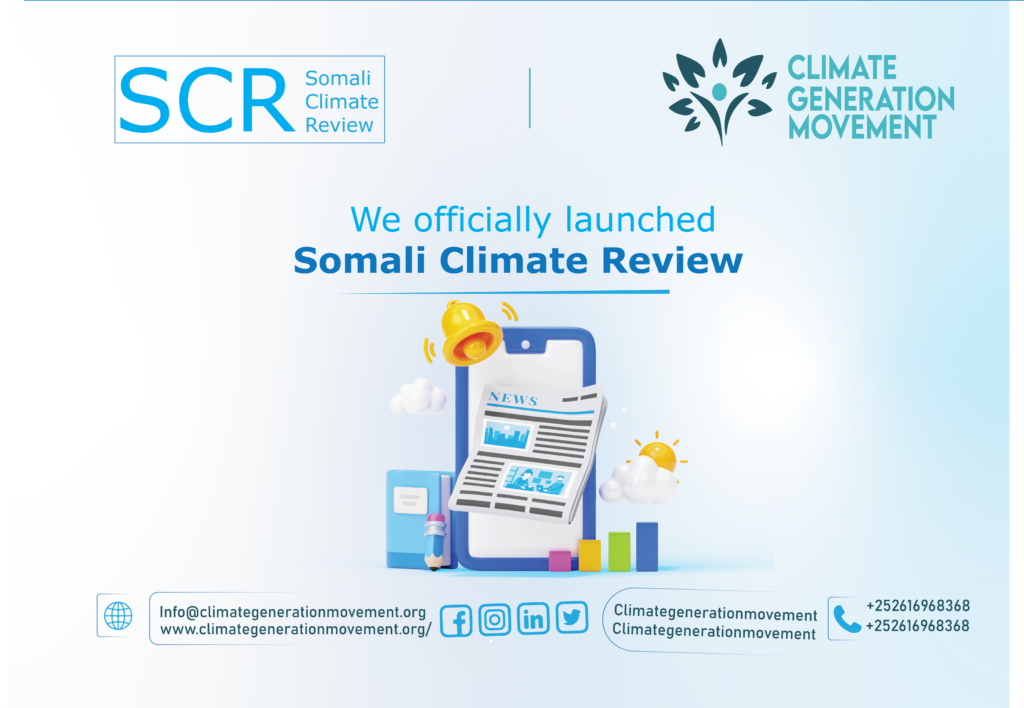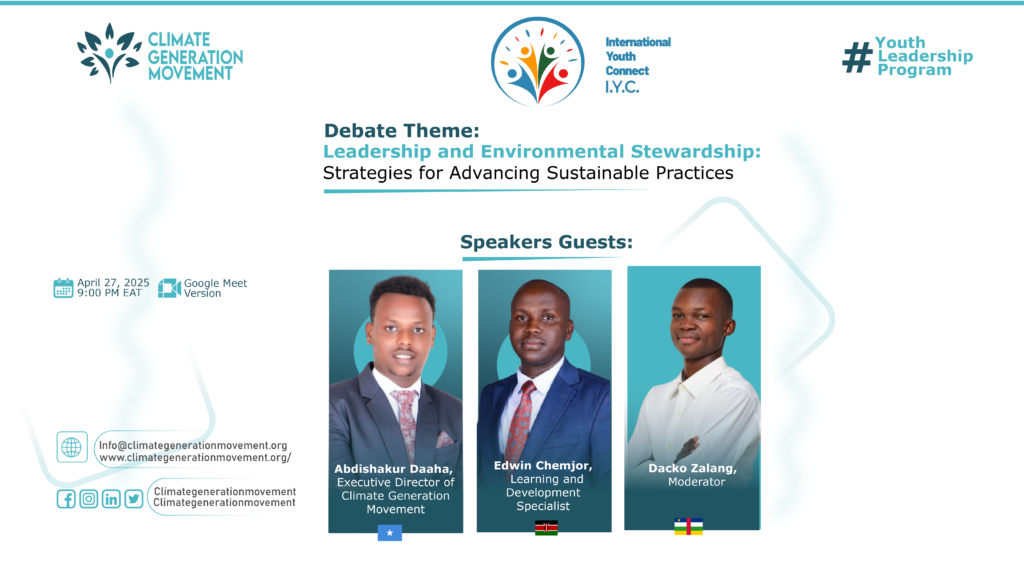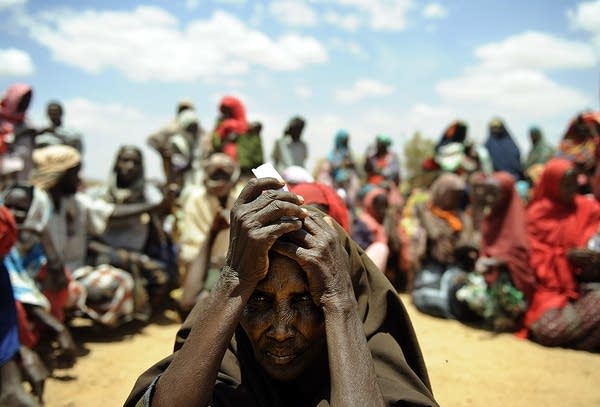The Somali Climate Review
1. Overview
The Somali Climate Review is Somalia’s leading climate-focused magazine and the flagship publication of the Climate Generation Movement. It serves as the country’s main platform for climate intelligence, environmental foresight, and sustainability discourse. Its purpose is to bridge gaps between scientific research, policy, and community action, providing insights that are both practical and forward-looking.
- Purpose: Provide evidence-based analysis and actionable insights on climate trends and sustainability.
- Audience: Policymakers, civil society, youth, researchers, and the general public.
- Approach: Integrates environmental science, policy analysis, technology, and social innovation.
- Formats: Print, digital, multimedia (podcasts, videos, infographics).
The magazine emphasizes inclusive reporting, giving voice to youth, local leaders, and environmental practitioners, ensuring that the content is accessible, participatory, and actionable.
2. Vision & Mission
Vision: To establish Somalia as a regional knowledge hub for climate action, empowering stakeholders to implement sustainable solutions and build resilience.
Mission:
- Strengthen climate-resilient governance through data-driven policy insights.
- Foster civic innovation and youth-led environmental initiatives.
- Promote evidence-based public discourse on climate change, renewable energy, and sustainability.
- Inspire communities to adopt green practices and proactive climate action.
Objectives:
- Provide credible, research-backed information to guide strategic decision-making.
- Influence policy development and legislative action on sustainability.
- Highlight local and regional climate solutions for replication and scaling.
- Foster cross-sector collaboration among government, private sector, and civil society.
3. Thematic Focus & Content Areas
a. Climate Science & Environmental Trends
- Analysis of local and regional climate patterns, extreme weather, and climate risks.
- Research on ecosystem degradation, water scarcity, desertification, and biodiversity.
- Data-driven adaptation strategies for communities and organizations.
b. Policy & Governance
- Updates on national and regional climate policies and regulations.
- Strategies for integrating resilience into urban planning, infrastructure, and public services.
- Insights on climate finance, development goals, and cross-sector collaboration.
c. Innovation & Technology
- Renewable energy adoption, solar and wind solutions, sustainable agriculture.
- Highlighting green startups, social entrepreneurship, and tech-enabled climate solutions.
- Digital tools for monitoring, forecasting, and modeling climate impacts.
d. Youth & Community Engagement
- Stories of grassroots initiatives, leadership programs, and civic participation.
- Capacity-building programs and storytelling to inspire local climate action.
- Empowering youth and communities to co-create solutions for sustainability.
e. Opinion & Thought Leadership
- Contributions from climate experts, researchers, and policy makers.
- Forward-looking analysis and innovative proposals for systemic change.
- Content that sparks debate, advocacy, and public engagement.
4. Target Audience
The Somali Climate Review caters to multiple stakeholders:
- Government and Policymakers: Strategic insights for climate-resilient planning.
- Environmental Professionals & Researchers: Advanced analysis, trend forecasting, and case studies.
- Youth Leaders & Activists: Inspiration, capacity building, and storytelling platforms.
- Academia & Students: Educational resources, research-based content, and innovative practices.
- General Public: Accessible and engaging stories promoting awareness and behavioral change.
Distribution Strategy:
- Urban and rural communities reached through print, digital, and multimedia formats.
- Interactive content such as webinars, podcasts, and infographics for engagement.
5. Impact & Expected Outcomes
Key Impacts:
- Inform: High-quality insights that guide policy, planning, and community action.
- Influence: Shape climate discourse and advocate for sustainable development.
- Inspire: Empower youth and communities to take tangible climate action.
- Connect: Foster cross-sectoral collaboration among government, NGOs, and private sector.
Expected Outcomes:
- Increased awareness and understanding of climate trends and sustainability practices.
- Adoption of evidence-based policies and climate-resilient strategies.
- Enhanced youth participation and leadership in environmental initiatives.
- Stronger networks for knowledge sharing, innovation, and civic engagement.
- Measurable contributions to local and regional climate resilience and sustainability.
6. Format & Distribution
- Print & Digital Editions: Quarterly publications for wide accessibility.
- Multimedia Integration: Infographics, videos, podcasts, and interactive webinars.
- Special Issues: Focused on emerging trends, innovations, and urgent climate challenges.
- Open Access Content: Free resources to support research, education, and public engagement.
7. Strategic Partnerships
- NGOs & Civil Society: Collaborative reporting, research, and community programs.
- Academic Institutions: Data, research publications, and expert contributions.
- Government & Regional Agencies: Policy insights, climate planning, and knowledge sharing.
- Youth Networks & Social Innovators: Amplifying grassroots initiatives and capacity building.
8. Conclusion
The Somali Climate Review is more than a magazine; it is a knowledge-driven advocacy platform, a catalyst for innovation, and a strategic tool for climate resilience. By combining research, storytelling, and policy analysis, the magazine empowers Somalia and the Horn of Africa to navigate climate challenges, innovate solutions, and build a sustainable, climate-resilient future. Its multi-format approach ensures that the information reaches diverse audiences while inspiring action at all levels, making it a vital resource for decision-makers, practitioners, youth leaders, and communities committed to sustainability and climate action.



